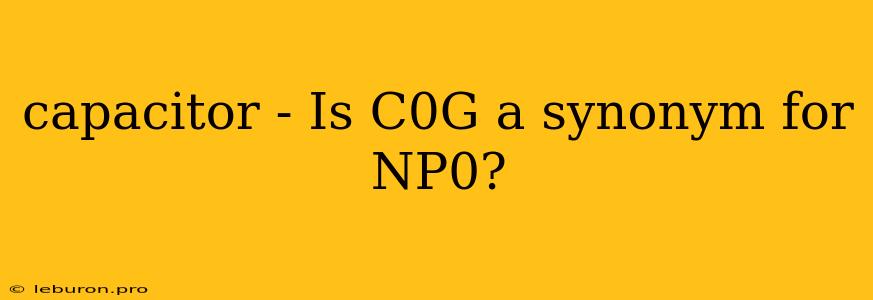Is C0G a Synonym for NP0? Understanding Capacitor Dielectric Materials
The world of electronics is replete with technical jargon, and for someone venturing into the world of capacitors, terms like C0G and NP0 might seem daunting. While these terms might appear interchangeable at first glance, understanding their nuances is crucial for selecting the right capacitor for your specific application. This article aims to clarify the relationship between C0G and NP0, delving into the intricacies of capacitor dielectric materials and their impact on circuit performance.
Capacitors, as essential components in electronic circuits, act as energy storage devices. Their fundamental function relies on the separation of charges between two conductive plates separated by a non-conductive material called a dielectric. The dielectric's properties significantly influence the capacitor's performance, determining its capacitance value, temperature stability, and voltage handling capacity.
The Significance of Dielectric Materials in Capacitors
Dielectric materials form the heart of a capacitor. Their ability to store electrical energy is characterized by their dielectric constant (k), which measures the material's ability to polarize under an electric field. A higher dielectric constant translates to a greater capacitance for a given capacitor size. However, the choice of dielectric material extends beyond merely maximizing capacitance.
C0G and NP0: A Look at the Temperature Coefficient
In the world of capacitors, C0G and NP0 are often used interchangeably, as they represent the same temperature coefficient of capacitance. The temperature coefficient reflects how the capacitance of a capacitor changes with temperature variations. Both C0G and NP0 signify a zero temperature coefficient, implying that the capacitance remains relatively stable across a wide temperature range.
Here's where the nuance lies: C0G and NP0 are not technically synonyms. They are specifications defined by different standards, primarily the EIA (Electronic Industries Alliance) and the JIS (Japanese Industrial Standards).
- C0G is the EIA specification for a capacitor with a zero temperature coefficient.
- NP0 is the JIS specification for the same characteristic.
While both standards designate capacitors with a zero temperature coefficient, their testing methodologies and tolerances might differ slightly. However, in practical terms, these differences are often negligible for most applications.
Advantages of Zero Temperature Coefficient Capacitors (C0G/NP0)
- Stability: C0G/NP0 capacitors exhibit exceptional stability, maintaining their capacitance value even when exposed to extreme temperatures. This makes them suitable for applications requiring high precision and stability, such as oscillators, filters, and high-frequency circuits.
- High-Frequency Performance: The low dielectric loss associated with C0G/NP0 materials enables these capacitors to perform well at high frequencies. They are preferred in RF applications, where signal distortion due to dielectric losses needs to be minimized.
- Reliability: The inherent stability and low loss characteristics contribute to the reliability of C0G/NP0 capacitors. They are chosen for critical applications where component failure can have severe consequences.
When to Use C0G/NP0 Capacitors
C0G/NP0 capacitors are ideal choices for applications where high stability, high frequency performance, and long-term reliability are paramount. Examples include:
- Precision Oscillators: Their excellent temperature stability is crucial for maintaining the frequency accuracy of oscillators used in timing circuits and communications systems.
- RF Filters: In high-frequency circuits, C0G/NP0 capacitors minimize signal losses and ensure the efficient filtering of specific frequency bands.
- High-Speed Digital Circuits: Their fast switching characteristics and low losses are essential for optimal performance in high-speed digital circuits, minimizing signal degradation.
- Temperature-Sensitive Applications: Whenever circuits are exposed to fluctuating temperatures, the stability offered by C0G/NP0 capacitors ensures consistent performance.
Beyond C0G/NP0: Exploring Other Temperature Coefficients
While C0G/NP0 capacitors excel in stability, they are not always the most cost-effective option. For applications less demanding in terms of temperature stability, alternative dielectric materials with varying temperature coefficients are available.
- X7R: Offers a broader operating temperature range with a moderate temperature coefficient. Suitable for general-purpose applications where stability requirements are less stringent.
- X5R: Offers an even broader temperature range than X7R, but with a higher temperature coefficient. Ideal for applications where cost is a primary concern.
- Y5V: Provides the highest capacitance value for a given size but has the most significant temperature coefficient. Suitable for applications with limited temperature variations and where cost is paramount.
Choosing the right dielectric material for your capacitor application involves balancing factors like performance, cost, and temperature sensitivity. Understanding the characteristics of various temperature coefficients allows you to select the optimal capacitor for your circuit's needs.
Conclusion: C0G and NP0 - Equivalents with Different Origins
While C0G and NP0 are often used interchangeably, they represent the same zero temperature coefficient under different standards. Both offer exceptional stability and reliability, making them ideal for applications demanding high precision, high-frequency performance, and consistent operation across a wide temperature range.
In the realm of capacitors, understanding the nuances of dielectric materials like C0G/NP0 is essential for making informed decisions. By choosing the appropriate capacitor based on its dielectric properties, you ensure the optimal performance and reliability of your electronic circuits.
